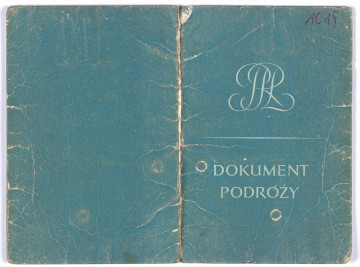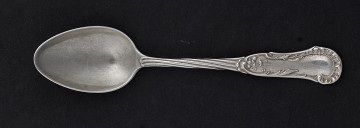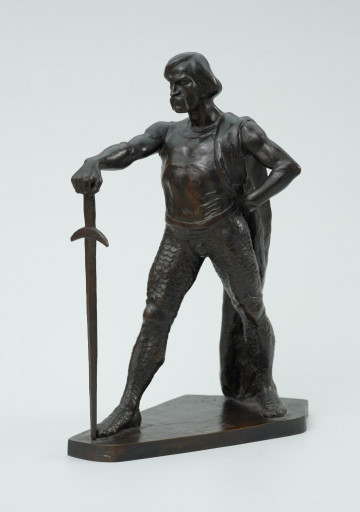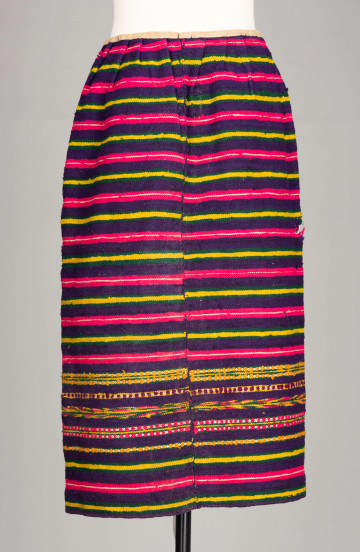
A travel document
1969
Museum of the history of Polish Jews
Travel documents were passports issued by the People's Republic of Poland to people who were not its citizens. Such people were referred to as "stateless persons" - a term which had been in use since the interwar period, when this specific type of passport was introduced for people who did not have any citizenship or who remained without any documents outside their country of residence. Such documents, necessary to move around the world - to leave a given country (issuing the document) and to enter another one - were called "non-citizen passports", or: "Nansen documents" (after the name of the creator of this type of document).
Polish Jews in the period of March '68 (1968-1972) became "stateless" because they had to renounce Polish citizenship officially, unconditionally. In the accounts of those who left, the moment of signing the renunciation of citizenship often recurs as one of the most traumatising. Many donors, when giving their travel documents to the collection, emphasised that the object was for them a material carrier of those emotions, as a kind of extension of the document of "renunciation" of citizenship.
Peotravel documents for Polish Jews were issued in the People's Republic of Poland at the turn of the 1960s and 1970s for travel to Israel, regardless of the actual purpose of the trip. This helps historians to determine approximately how many Polish Jews were leaving at that time: 13,000 (see especially: Dariusz Stola, ''Kraj bez wyjścia. Migracje z Polski 1949-1989'' [Country without Exit. Migrations from Poland 1949-1989], Warsaw 2012, chapter 9, pp. 212-232). Let us stress: this is a lower limit, since some people (however few) were able to leave Poland not only to Israel oficially or were using "ordinary" passports (this is how Jerzy Lipman with his wife Eugenia née Abramowicz - a doctor, and their son left Poland; see also, for example, the account of the Sagalar family in the POLIN Museum's collection of oral histories).
Until the end of 1968, travel documents were issued in the form of a single folded sheet, the so-called accordion in the cover. From 1969, travel documents had the form of a multi-page booklet.
The layout of the contents in the travel documents - also in single-sheets - was by default turned 90 degrees in relation to the layout of the opening of the booklet, which was oriented vertically. This moment of changing the format of the document can be seen in one of the archival groups in the museum's collection: there are archival materials related to the Borowicz family's trip. Three travel documents were issued at the turn of 1968 and 1969: one in 1968. (for Marta Borowicz, daughter; later married name Stiller), and this one is in accordion form (document series and number: HA 0063134), while two were issued as early as 1969 (for Mieczysław Borowicz and for Franciszka Borowicz, who was issued a document for her and for her then under-age son, Henryk) - these are in book form (document series and number: DEA 0000018 and DEA 0000011 respectively).
The documents contained on pages 2 and 3 a description of the person (a photograph on page 3; in the case of documents for a parent and child, a photograph of both, as in the case of the document for Franciszka and Henryk Borowicz).
At the top of p. 2 there is an inscription:
The holder of this travel document is not a Polish citizen
[below in smaller letters Russian and French language versions].
On p. 6 an imprint in the upper left corner:
The travel document entitles
To leave the People's Republic of Poland for a country
People's Republic of Poland to a country:
[below in smaller letters Russian and French language versions].
in the period until:
[below in Russian and French].
Hence the documents were colloquially referred to as: "one-way passport".
On this p. 6, on the right, stamps - also trilingual - were affixed at the appropriate height:
ALL COUNTRIES OF THE WORLD or ALL COUNTRIES OF EUROPE AND OUTSIDE EUROPE
and a date, given in the format:
day, written in figures; month, written in words in three languages; year, written in figures; plus the last digit of the year in words.
These were the dates until which the document was valid for departure.

XIX/XX wiek
Castle Museum in Łańcut

około 1912
National Museum in Szczecin

19th/20th century
National Museum in Lublin
DISCOVER this TOPIC
National Museum in Szczecin
DISCOVER this PATH
Educational path